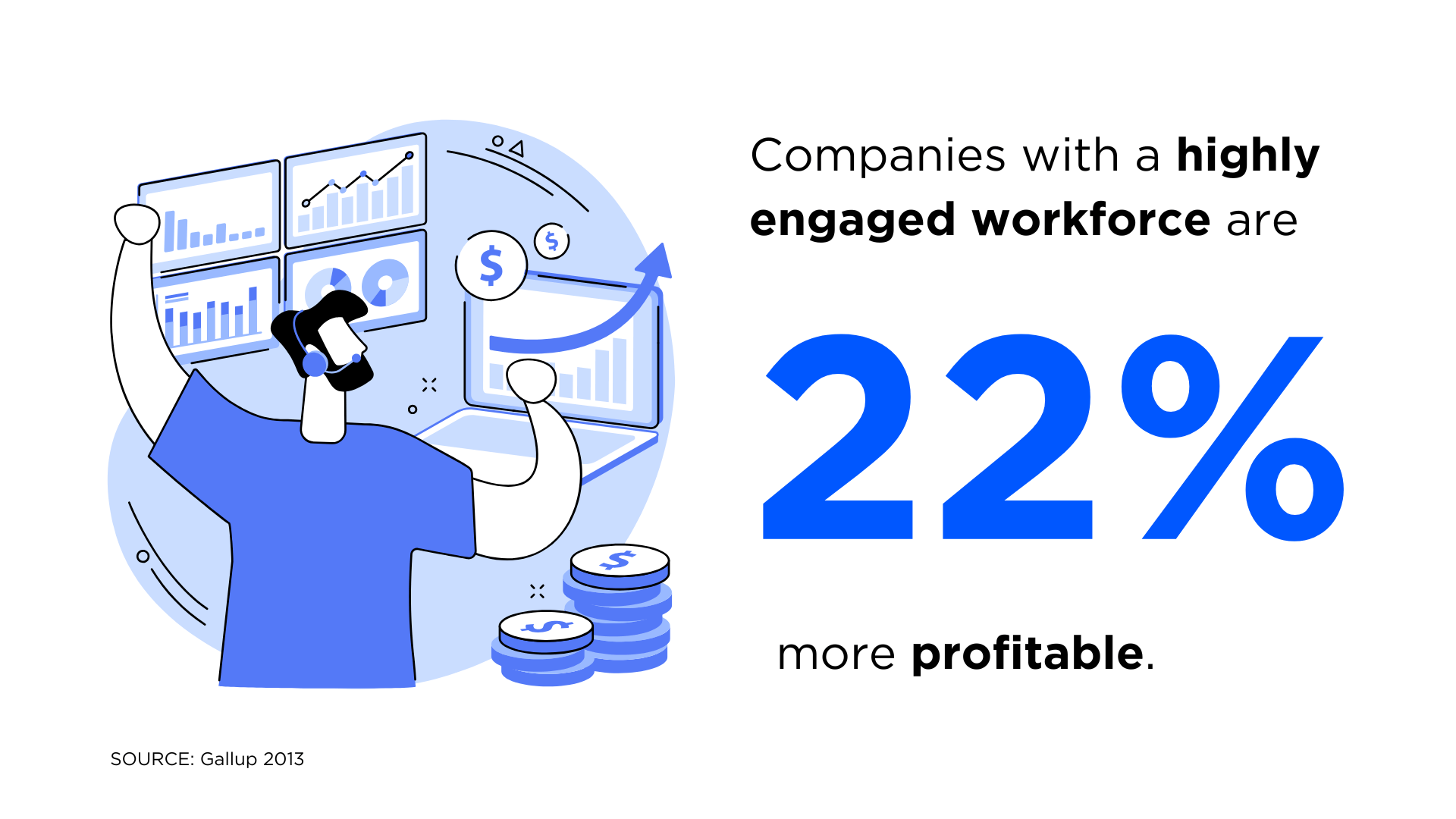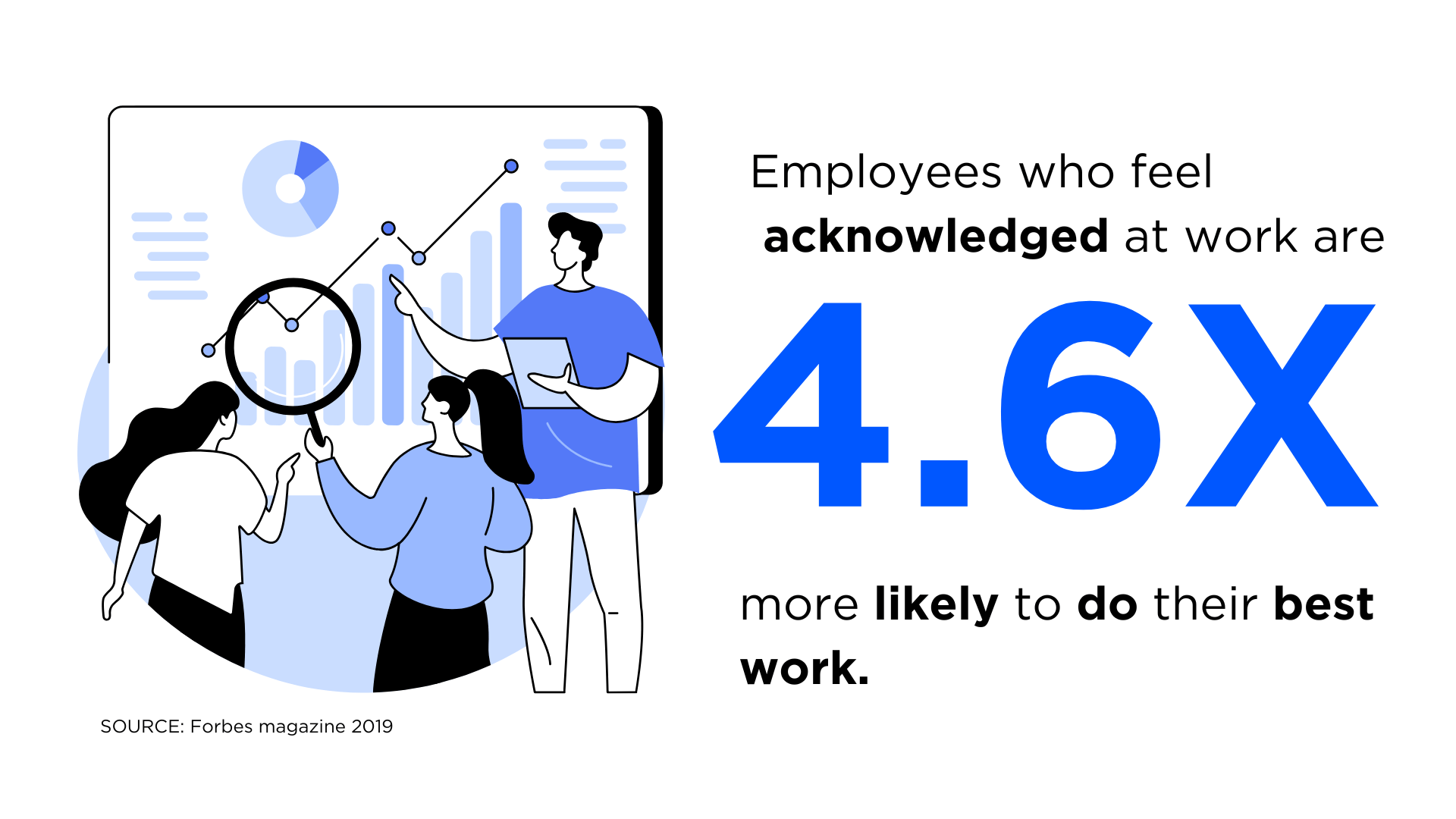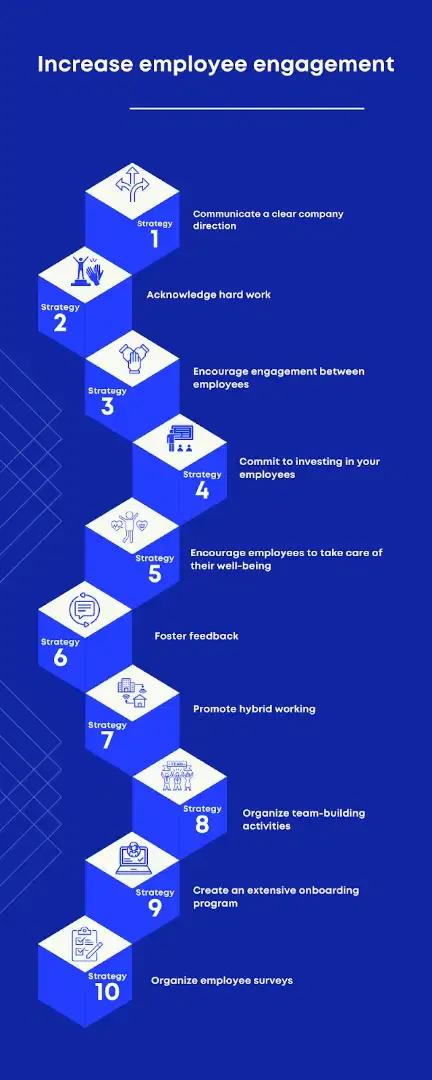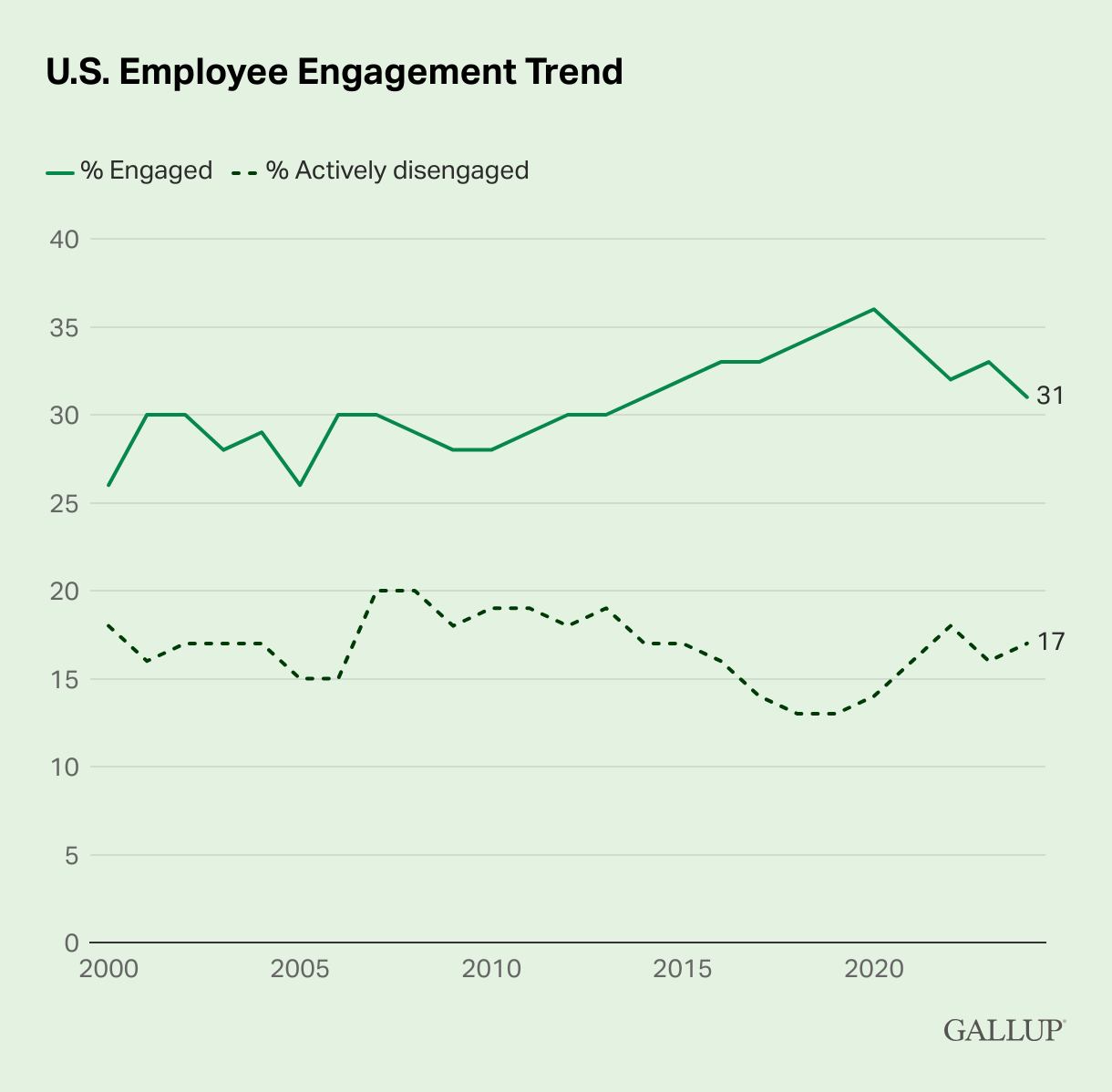Employee engagement in the U.S. has been on a bit of a downward spiral since 2020, hitting a 10-year low of 31% in 2024, while disengagement climbed to 17%.
You might think those numbers sound low, but only 18% of U.S. workers feel extremely satisfied with their working conditions, and just 31% strongly agree they’ve had career development opportunities to learn and grow—a figure that’s been dropping since 2020.
To top it off, PwC found in 2024 a striking employee turnover statistic: more employees are planning to jump ship than during the ‘Great Resignation’ of 2022—and lack of upskilling opportunities is a big reason why.
But, why does employee engagement even matter?
Simple—when your team is truly engaged, they don’t just show up; they excel, innovate, and push your business forward.
While many companies dream of high engagement and employee satisfaction, only a select few have nailed it—according to Gallup, these exceptional workplaces boast a 70% employee engagement rate.
What’s their secret sauce, you ask?
Buckle up, because we’re about to dive into the engagement activities, strategies and initiatives that will not only boost employee engagement and in turn employee development but also turn your workplace into a buzzing hub of enthusiasm and commitment.
Ready? Let’s go!
What is employee engagement?
Employee engagement is the deep-rooted connection and commitment an individual feels toward their job role and the organization they’re a part of.
It goes deeper than just being satisfied with a paycheck or enjoying workplace perks. It’s about employees:
- Truly believing in the company’s mission and company values,
- Feeling valued
- Thinking they’re making a positive impact,
- Having learning opportunities for professional growth, and
- Wanting to give their best effort every day.
Of course, tangible benefits like bonuses or cool office spaces might catch an employee’s attention, but it’s these aforementioned deep-seated factors that boost employee engagement in the long run.
Engaged employees are committed and fervently champion their workplace in their day-to-day while bringing in the enthusiasm, innovation, and drive they need to go the extra mile.
Plus, research shows that companies with a highly engaged workforce are 22 percent more profitable and 21 percent more productive than those with disengaged staff.

So why is nurturing this kind of engagement vital? Let’s explore the multiple benefits to find out.
Benefits of improving employee engagement
Employee engagement isn’t a ‘nice-to-have’; it’s a necessity. It’s a potent driving force that influences many parts of work—from individual productivity and team collaboration to managerial effectiveness.
Here are the ripple effects that stem from a truly engaged workforce:
Team performance improves
When one individual brings their ‘A’ game, it creates a ripple effect throughout the team, nudging others to improve their performance too.
Why? Because “Nothing is as contagious as enthusiasm,” (Samuel Taylor Coleridge).
There’s something undeniably magnetic about being surrounded by a team with top talent that’s not just working but thriving collectively. It can draw even the most reserved into the flow.
For example, being around high-level performers at a large technology firm boosted the performance of coworkers by 15%.

And when employees are deeply connected to their roles and the company’s vision — their performance peaks.
Now, imagine an entire team inspired by this spirit. The result? Collective excellence for the organization.
Productivity increases
According to Gallup, productivity increases by 14 percent when employees are enthusiastic about their roles.
What does this mean? This means when employees feel genuinely engaged with their work, their approach goes beyond the routine of clocking in and out.
They tend to give more attention to their projects, clients, and challenges, aligning their personal success with the company’s goals.
This conscious engagement positively influences not only their individual performance but also contributes to the overall productivity of the team.
Team goals are achieved
Achieving team goals is a collective effort — which is directly tied to how invested each member is in those milestones. So, when a team is engrossed in a clear, compelling company narrative, their engagement skyrockets.
For example, instead of your marketing team just launching campaigns; each member will passionately tell your brand’s story, because they’re plugged into the organizational vision.
The result? A culture where goals are ticked off, creating a narrative of continuous development and triumph within the organization.
Stress in the workplace is minimal
Navigating through workplace stress significantly rests on one key element: employee engagement.
Let’s think about it this way; an engaged employee will approach stress not as an obstacle but as a stimulating challenge, a chance to learn new skills.
Why? Because their connection to the company’s purpose provides a buffer for them to cope more effectively and even use ‘stress’ as a motivational force.
A study has shown that over 60 percent of highly engaged employees believe their work positively influences their physical health
In contrast, a disengaged employee will perceive stress as a stumbling barrier, potentially impacting both their well-being and work quality.
Therefore, creating an environment where team members feel seen, heard, and valued builds engagement and turns potential stressors into enthused workers.
Indeed, employees who feel acknowledged at work are 4.6 times more likely to feel motivated to do their best work.

So, the goal isn’t to eliminate stress entirely but to channel it into a force that propels progress while safeguarding employee wellness. This is the true power of a supportive and engaged workplace.
Low burnout rate
When employee burnout often stems from unmanaged, persistent workplace stress, it isn’t just a personal struggle — it’s also an organizational challenge.
Burnt-out employees are 63 percent more likely to take a sick day and 2.6 times as likely to be actively seeking a different job.
So, what’s the remedy?
Genuine, consistent employee engagement.
When you immerse your team in a supportive and engaging work environment, you’re safeguarding their well-being and maintaining a balanced and thriving work environment.
In essence, true employee engagement is an investment in the complete vitality of your employees and, by extension, your organization.
Now, let’s look into the strategies you need to make these benefits a reality in your organization.
10 strategies to improve employee engagement
Engaging your employees isn’t merely about keeping them happy; it’s about igniting the spark that fuels their performance, creativity, and commitment.

Here are 10 key strategies that can help you increase employee engagement:
Strategy #1. Communicate a clear company direction
Starting a journey without a map is bound to be chaotic. Now, let’s apply this to the workplace.
Employees want a sense of direction and purpose, not to feel like faceless cogs in a machine. Instead, they should feel like their contributions are moving the company forward.
Based on a survey, 50 percent said they didn’t get a feeling of meaning and significance from their work, but those who did:
- Reported 1.7 times greater job satisfaction.
- Were 1.4 times more engaged.
- Were more than three times as likely to remain with their current employer.
Therefore, creating and communicating a clear company mission and set of core values puts the wind in your team’s sails — moving them toward engaged, purpose-driven work.
Key takeaway: From day one, clarity is king. An LMS, like Docebo, makes it easier for you to engage new hires during the onboarding phase.
By creating hyper-personalized experiences for your employees, it’s easier to keep them engaged as you shed light on the company’s culture, the impact of their roles, and the expectations that you have of them.
Strategy #2. Acknowledge hard work
69 percent of employees report that they would work harder if they felt more appreciated at work.
However, recognizing and appreciating hard work isn’t simply about saying “thank you”. It’s about establishing a culture that consistently and genuinely acknowledges effort and achievement.
So, provide genuine employee recognition at any level — whether they cross a significant milestone, launch a successful project, or bring an innovative idea to the stage.
This way, their dedication during those late nights and their innovative problem-solving won’t go unnoticed.
Key takeaway: An LMS with gamification capabilities, like Docebo, allows you to use badges, leaderboards, rewards, points, and contests to make learning and development for your team rewarding and fun.
Strategy #3. Encourage engagement between employees
Encouraging engagement between team members — whether within a single department or across various units — is crucial for improving productivity and nurturing a sense of belonging.
According to Clear Company, about 75 percent of employers rate teamwork and collaboration as “very important”.
So, it’s clear that leadership needs to make collaboration a core part of the company’s engagement initiatives. This can be done by ensuring everyone has the necessary tools for smooth collaborative efforts — especially in a remote working environment.
Plus, talking openly about employee engagement and making it a visible part of your company culture signals its importance, builds trust, and aligns the entire organization toward shared goals.
Key Takeaway: Efficient collaboration is vital, and LMS platforms like Docebo can act as engagement software, playing a vital role in driving employee engagement. Docebo provides a centralized space for knowledge sharing and communication, thereby bridging gaps between departments and promoting a vibrant and engaged work environment.
Strategy #4. Commit to investing in your employees
Offering professional development programs and opportunities improves employee experience and profitability as it directly impacts business success.
According to LinkedIn, 94% of employees would stay at a company longer if it invested in their learning and development.
Nurturing employee growth isn’t just beneficial for retention but also for long-term business prosperity.
AI Learning Management Systems (LMSs) or AI learning platforms like Docebo help take employee training to the next level. With features such as AI-powered upskilling, Docebo crafts learning paths that cater to an employee’s current skills and aspirations.
And, with its robust data and analytics functionality, Docebo doesn’t just offer training; it ties talent development to tangible business outcomes.
Key Takeaway: Consider the words of Richard Branson: “Train people well enough so they can leave; treat them well enough so they don’t want to.”
Strategy #5. Encourage employees to take care of their well-being
A healthy workforce contributes to an individual’s vitality and also improves the overall vibrancy and performance of the organization.
Employees with high well-being in all five elements — physical, social, community, financial, and purpose — are 41 percent less likely to miss work due to poor health.
So, prioritizing your employee well-being improves their health and enriches the company’s productivity as a result.
An environment that promotes wellness is an investment in the longevity of your company, while cultivating a culture where individuals can thrive.
Key takeaway: An effective employee engagement strategy should always prioritize your employees’ mental health and well-being. For example, addressing aspects like mental health ensures a reduction in absenteeism and enhances employee experience.
Strategy #6. Foster feedback
Employees who receive daily, meaningful feedback from their manager are 3.5x more likely to be engaged than those who receive feedback once a year or less. That’s why it’s so important to incorporate feedback as part of your performance management strategy.
The thing is, employees don’t just appreciate feedback; they seek it to align their performance with workplace expectations.
But it’s more than just words; it’s about creating a two-way street where communication leads to real change. Regular check-ins and one-on-ones are key, but they should be part of a wider culture where everyone’s voice is valued and acted upon.
Such a culture could include mentorship programs run by human resources or your L&D team.
Ensuring there’s an open channel for employee feedback and open communication is crucial. This uplifts them and gives leaders valuable insights to shape a positive work environment.
Key Takeaway: Platforms like Docebo help ensure every piece of feedback is heard and smartly used, thanks to its optimized survey techniques. This nurtures a space where both employee and company growth move forward hand in hand.
Strategy #7. Promote hybrid working
According to a survey by Accenture, 83% of workers prefer a hybrid work model.
So, embracing a hybrid work model or a flexible work schedule aligns with the evolving norms of the work environment. Plus, it shows a personal investment in your employees’ work-life balance.
Instead of being rigid, foster a culture that supports a balance of in-office and remote work.
This adaptive approach keeps teams happy and productive while reflecting an empathetic leadership style that respects individuality.
Key Takeaway: Remember, flexibility in approach enriches an inclusive, robust, and dynamic workplace culture. Take advantage of platforms like Docebo to help align development, communication, and collaboration, regardless of where your team is located.
Strategy #8. Organize team-building activities
Team-building activities are more than just a break from the daily grind; they’re pivotal in shaping a work culture where employees feel engaged, connected, and appreciated.
Plus, they can serve as the glue that holds employees steady amid organizational challenges.
Here are a few employee engagement ideas:
- Trust-building exercises like Minefield or Back-to-Back Drawing improve reliability and support among team members.
- Activities like Pictionary Relay or 20 Questions help employee communication skills within the team.
- Activities like Bridge Build or Egg Drop challenge collective problem-solving, innovative thinking, and strategizing skills.
- Step outside the office with activities like a scavenger hunt or Geocaching to combine the thrill of adventure with teamwork.
- Organize artistic or creative competitions like an improv workshop or Build a Story to offer platforms for spontaneous thinking and imaginative expressions.
Key Takeaway: Select activities that can act as incentives or align with your organizational objectives to ensure that these aren’t just fun days but also knit your team more tightly together.
Strategy #9. Create an extensive onboarding program
According to Zippia, organizations with strong onboarding processes increase new hire retention by 82% and improve productivity by 70%.
Thus, a strategic onboarding pathway is crucial, especially for new employees. This not only impacts employee retention but also ensures that they understand the company’s core values.
The key aspects to spotlight in an onboarding program include:
- Company insights to immerse new hires in the company’s mission, values, and working style
- Knowledge about organizational workflows
- Vital resources and a sturdy support network
- Opportunities to mingle, connect, and build relationships with their new colleagues
- Clarified expectations through performance metrics, behavioral norms, and contribution expectations
- Regular check-ins to assess, appreciate, and constructively critique their progress
Key takeaway: Leveraging an AI LMS or AI learning platform like Docebo can seamlessly intertwine the above elements. With capabilities like automated workflows, a vast content library, and AI-powered personalization, you can ensure that onboarding is an experience that sets a positive and engaging tone for any employee’s journey.
Strategy #10. Organize employee surveys
Employee engagement surveys or pulse surveys pave the way for insightful data regarding the current employee engagement levels. So, they should inform a company’s decision-making.
Anonymity also plays a pivotal role in survey effectiveness, providing a secure avenue for candid, invaluable feedback without fear of repercussions.
It’s like extending a safe space where employee voices are echoed within the organization’s strategies and cultural norms.
However, the journey doesn’t end with gauging engagement. It rolls right into developing action plans and strategies that act on those insights, especially when it comes to training.
Key takeaway: You can dive deeper into the effectiveness of your employee training with Docebo’s powerful learning intelligence.
The Bottom Line
With Docebo, it’s not just about initiating learning experiences; it’s about weaving through the journey from capturing employee needs with surveys to lighting up their learning path.
If you’d like to see what this will look like for your team, take a tour of the platform and consider booking a demo.
